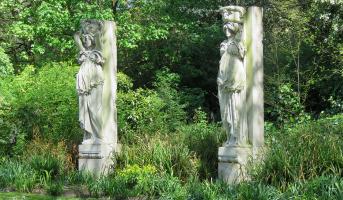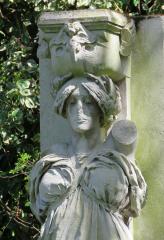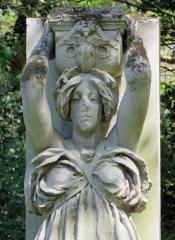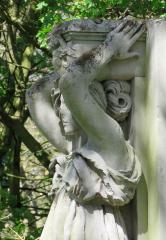 Rotherhithe Town Hall Caryatids in Southwark Park, by Henry Poole.
Rotherhithe Town Hall Caryatids in Southwark Park, by Henry Poole.
 Rotherhithe Town Hall Caryatids in Southwark Park, by Henry Poole.
Rotherhithe Town Hall Caryatids in Southwark Park, by Henry Poole.
In Southwark Park, South London, stand two very large caryatids – statues of girls in place of pillars intended for supporting architecture. Here, they support only the brackets on their heads, which are carved as ships’ prows, and nothing above. They are damaged, with one lacking her arms, both with damaged faces, and very worn. Yet they have the grandness of an ancient ruin, a gracefulness of pose, and a certain beauty of the turn of the 19th Century. Their symbolist style and symmetrical faces date them firmly between 1890 and 1910, and they are in fact the surviving sculpture from Rotherhithe Town Hall, erected in 1897.
Rotherhithe Town Hall, shown in this rather blurry photograph, was a distinctive building in an eclectic Renaissance style between late Victorian and Edwardian: thus the distinctive horizontal banding of Portland stone and red brick recollects Westminster Cathedral and the surrounding blocks of similar date, while the frontage and clock stage of the tower presage the Edwardian Baroque characteristic of a few years later. The few pictures I have seen of this building all show this same view, which I think is simply because the street is not that wide, and this was the best angle from which the tower could be seen. The architects were Murray and Foster, Adelphi Chambers, John Street, London, and the main sculptural feature was this pair of caryatids flanking the main entrance and supporting a broad balcony above. The sculptor was Henry Poole, known for his architectural sculpture for various buildings by the architectural partnership of Lanchester and Rickards, above all Cardiff City Hall and in London, Westminster Central Hall.

 Caryatids as statuesque girls with Arts and Crafts features.
Caryatids as statuesque girls with Arts and Crafts features.
Anyway, back in Rotherhithe, the Town Hall housed a museum and library from 1905, and was severely damaged by World War II bombing, after which it was pulled down. The caryatids survived, and found their way to an estate, which was itself pulled down in 2009; the caryatids were emplaced in Southwark Park in 2011.
 Side view showing her coiled hair.
Side view showing her coiled hair.
Let us look at the figures more closely. They stand in relaxed position, not uncommon in caryatids, despite the intent to support weight, and the arms of the figure where they survive shows her to be balancing the mass of the ship’s prow on her head rather than in any way bearing its weight. They are dressed in identical costume: long shifts, leaving the arms bare, with crossed straps between the breasts and the drapery looped around them, then everything below hanging in graceful drop-folds to the floor, where the feet of one girl are covered, and the other, while broken, have toes peeking out. Each figure has her drapery constrained somewhat below the waist by a garland of leaves; laurel on the one figure, oak on the other, this vegetation being reproduced in headbands too.
But while similar in outline, and each with her right leg (left as we look towards the statues) outlined by the flat drapes, variation is given overall by the folds of the cloth, to avoid the figures being mirror images. The sculptor has kept the drapery close enough to hug and outline the bodies, and we see these girls have the physiques of Valkyries, with broad, muscular shoulders and arms, broad of hip and heavy of thigh. But the faces, with their roundness of face, and symmetrically parted hair, pulled back to be tied in a bunch at the back, are firmly of the Arts and Crafts period. Note too the ship’s prows above, each with a winged female half-figure at the front. This is good work by a good sculptor, and we are fortunate that these caryatids have survived; the emplacement in Southwark park with trees and shrubs around provides an excellent setting and the Council are to be congratulated.
This page was originally part of a 'sculpture of the month' series, for August 2016. Although the older pages in that series have been absorbed within the site, if you would wish to follow the original monthly series, then jump to the next month (Sept. 2016) or the previous month (July 2016). To continue, go to the bottom of each page where a paragraph like this one allows you to continue to follow the monthly links.
Go West and North to nearby Bermondsey Old Town Hall, // or St Mary's Church, Bermondsey or North to St Mary Rotherhithe
Borough to Bermondsey: churches and sculpture // London sculpture // Sculptors
Visits to this page from 1 August 2016: 5,731